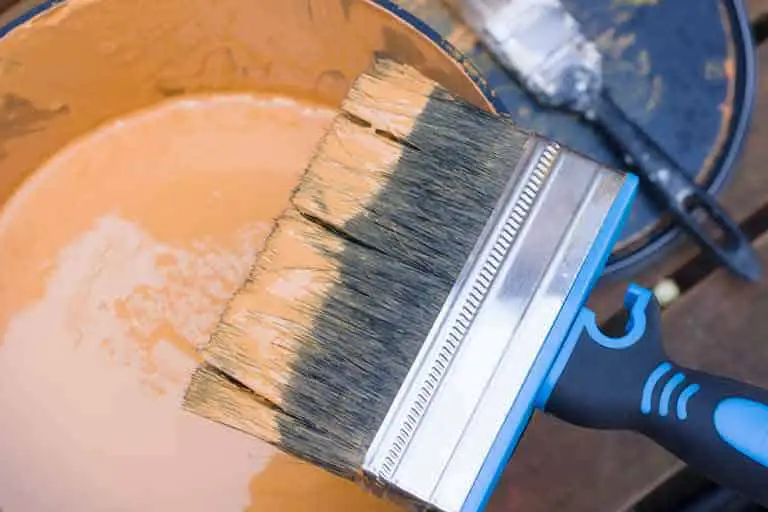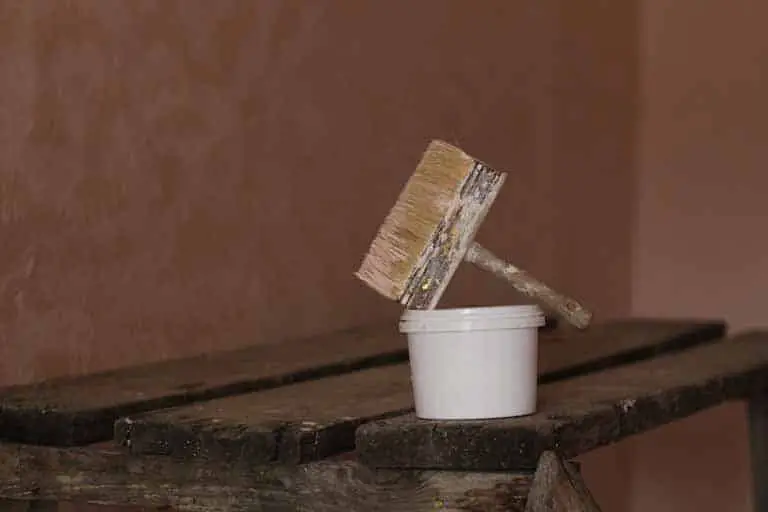
Limewash is a popular decorative finish that can give your walls a beautiful, natural matt finish. If you’re considering using limewash to decorate your home, you may wonder if it will rub off on your clothes.
Good quality limewash, applied properly to a suitable substrate, should not rub off readily onto clothes. However, there are some reasons why you may experience poor adhesion or dusting. These can include using ordinary bagged lime for preparation, applying coats too thickly, and inadequate dampening down before limewashing or drying out too quickly.
In this article, we’ll explore the pros and cons of limewash and discuss whether it can rub off on your clothes.
What is Limewash?
If you’re looking for a natural, breathable, and environmentally friendly way to decorate your walls, then limewash might be the perfect solution for you. Limewash is a type of paint made from the natural materials lime, water, and natural pigments. It has been used for centuries to protect and decorate buildings, especially those made from natural materials such as stone, brick, or adobe.
Limewash is a thin, milky liquid that penetrates the wall’s surface, creating a breathable layer that allows moisture to escape. This makes it ideal for use in older buildings that do not have damp-proof courses or modern ventilation systems. Limewash has a unique texture that gives walls a soft, mottled appearance, and it can be used to create a range of colours, from soft pastels to bright, vibrant hues.
Overall, limewash is a versatile and environmentally friendly way to decorate your walls. It is a natural material that allows walls to breathe and can be used to create a range of colours and textures. If you’re looking for a unique and natural way to decorate your walls, then limewash might be the perfect choice for you.
Related article: What is Limewash? An Overview of This Traditional Paint
Benefits of Limewash
If you consider using limewash as a decorative finish for your building, you will be pleased to know that it has several benefits.
Breathability
One of the most significant advantages of limewash is its breathable finish. This means it allows moisture to pass through it, which can help prevent damp and mould from forming on your walls. By using limewash, you can help to maintain a healthy living environment for you and your family.
Eco-Friendly
Limewash is an eco-friendly finish that is made from natural ingredients. It is non-toxic and does not release any harmful chemicals into the environment. Limewash is an excellent choice if you want an environmentally friendly way to decorate your home.
Durability
Limewash is a durable finish that can last for many years. It is resistant to weathering and can withstand harsh weather conditions. This makes it an excellent choice for buildings exposed to the elements.
Accessible
Limewash is an accessible finish that is easy to apply. You do not need any special skills or equipment to apply limewash to your walls. This makes it an excellent choice for DIY enthusiasts who want to update their homes without spending a lot of money.
Related article: Limewash Pros and Cons: A Comprehensive Guide

Does Limewash Rub off on Clothes?
If you’re considering using limewash for your home renovation, you may wonder whether it will rub off on your clothes. The good news is that properly applied limewash should not rub off on clothing.
How is Limewash Properly Applied?
Firstly, limewash should be applied to a suitable surface. It will work best with a porous surface. Very smooth and dense surfaces like smooth stone and other essentially waterproof surfaces are not suitable for limewashing. If limewash is applied, it will not adhere well and will rub and dust off. If you are unsure, do a small test patch to see how well the limewash will adhere.
Before limewash is applied, the surface must be clean of any debris, dust, oils, organic matter, old finishes and anything else that could cause an issue. Just before application, the surface must be dampened down with a mist sprayer or another way of applying water to the wall. As you apply limewash, the wall must remain damp (but not running with water).
Limewash should be applied in very thin coats. Limewash itself is much thinner than normal paints. It should have the consistency of milk; if it doesn’t, water should be added until it does. As you apply the limewash with a block brush, it will appear transparent. This is normal. Limewash gains its depth of colour and opacity as it cures.
Finally, limewash cures slowly by absorbing carbon dioxide out of the air. This can only take place while the surface contains moisture. Limewash must remain damp as it cures. You can hang damp hessian sheeting in front of the limewash to slow drying and lightly mist spray the surface. You should aim to allow limewash to dry slowly over 24 hours. After which, the next coat can be applied.
Related article: Best Number of Coats for Limewash: Expert Recommendations
Other Considerations For Limewash Rubbing Off on Clothing
It’s important to note that when limewash is still wet, it may transfer onto clothing if it comes into contact with it. Therefore, avoiding wearing your best clothes when applying limewash to your walls or other surfaces is recommended.
To prevent any potential transfer of limewash onto your clothes, it’s also recommended to cover yourself with protective clothing such as an apron or overalls. Additionally, it’s a good idea to clear the area of any furniture or other items that could come into contact with the limewash and transfer it onto your clothes.
If you get limewash on your clothes, washing them as soon as possible is best. Clear any excess limewash off the clothing, then wash it in cold water with a mild detergent. Do this as soon as possible before the limewash begins curing.
In summary, properly applied limewash should not rub off on clothes when applied correctly, but it’s important to take precautions to avoid any potential transfer of the material onto clothing. If you do get limewash on your clothes, wash them as soon as possible with cold water and mild detergent.

Reasons That Can Cause Limewash to Rub Off on Clothes
It can be frustrating to find your freshly applied limewash rubbing and dusting off. Luckily, a few main reasons will cause limewash to rub off, so a solution should be relatively easy to find.
Poor Application Methods
One of the main reasons that limewash can rub off on clothes is due to poor application methods. If the limewash is not applied properly, it can easily rub off onto clothing. This can happen if the limewash is applied too thickly, the surface is not properly prepared, or the limewash is not given enough time to dry.
Limewash Applied too Thickly
Another reason that limewash can rub off on clothes is if it is applied too thickly. If the limewash is applied in thick coats, it will crack and craze as it drys and will not properly adhere to the surface. This can cause the limewash to rub off onto clothing, especially if the surface is touched or rubbed against.
Lack of Carbonation
If the limewash has not properly carbonated, it can also rub off onto clothing. Carbonation is the process by which the lime in the limewash reacts with carbon dioxide in the air to form calcium carbonate. If the limewash has not properly carbonated, it may not have fully hardened and can easily rub off onto clothing.
Carbonation can only occur while the limewash is still damp. You should allow limewash to dry out very slowly over 24 hours. It can be slowed by gently mist spraying the surface or hanging damp hessian sheeting in front of the painted surface. By doing this, you allow limewash the time it needs to absorb enough CO2 to cure fully.
Applied to Non-Porous Surfaces
Limewash should only be applied to porous surfaces like brick, stone, or lime plaster. If it is applied to non-porous surfaces, such as metal or glass, it may not properly adhere and can easily rub off onto clothing.
If you want to paint a non-porous surface with limewash, this can be achieved using additives. Casein in limewash acts as a natural glue; this can help limewash adhere to more surfaces than it normally can. There are many different additives for limewash; this means almost all surfaces can be limewashed if the limewash contains the appropriate additive.
Made With Poor Quality Ingredients
Finally, limewash made with poor-quality ingredients can also rub off onto clothing. If the lime used to make the limewash is of poor quality, it may not properly adhere to the surface and can easily rub off onto clothing. Its also important to use water suitable for drinking as it will not contain organic matter or other impurities that could affect the paint finish.
In summary, there are several reasons why limewash can rub off onto clothing. These include poor application methods, applying the limewash too thickly, lack of carbonation, applying it to non-porous surfaces, and using poor quality ingredients. To avoid these issues, preparing the surface properly is important, applying the limewash in thin coats and allowing it to fully dry and carbonate before touching or rubbing against it.
Conclusion
Limewash is a popular decorative finish often used on old buildings due to its beauty and benign nature. When applied properly to a suitable substrate, limewash should not rub off readily onto clothes. However, poor adhesion can occur if preparation with ordinary bagged lime is used, coats are applied excessively thickly, or if there is inadequate dampening down before limewashing.
If you are concerned about the potential for limewash to rub off on your clothes, it is always a good idea to wear protective clothing and take necessary precautions. However, with proper application and preparation, limewash should not pose a significant risk of rubbing off on clothes.

